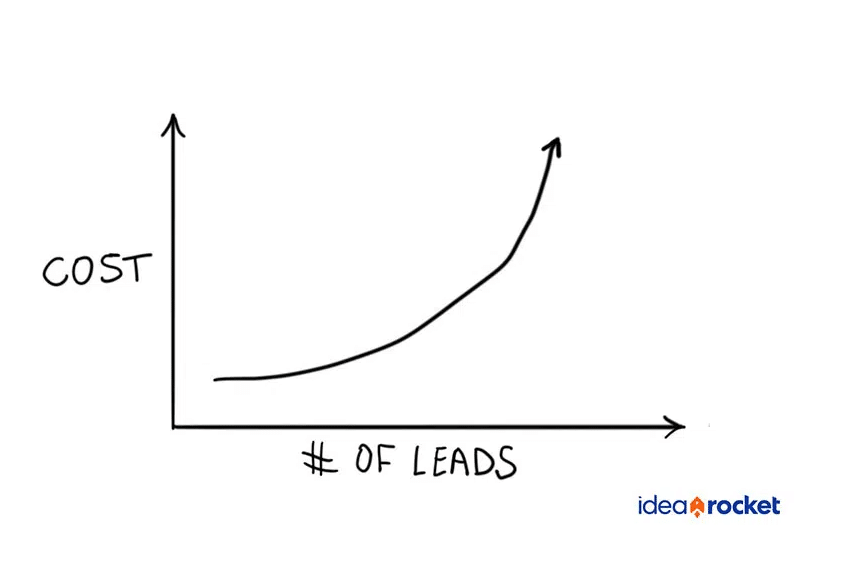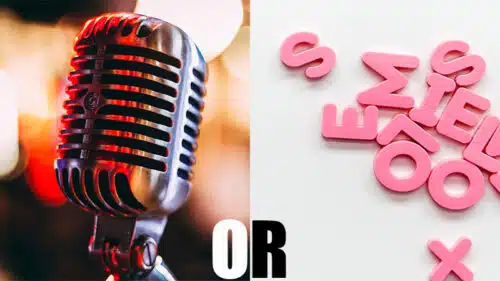Our job as B2B marketers is pretty straightforward. We seek to reel in as many prospects as we can as cost-efficiently as we can, so our companies can grow. But it isn’t long before we realize there’s a relationship between the amount of leads we bring in and their cost. The graph above summarizes the effect: the more leads we try to get, the more expensive each one is.
Why does this happen? Well, we’re not dummies — we’ll harvest all the low-hanging fruit before we start scaling the tree to pick the stuff at the tippy-top. Or, put another way, we’ll look to the free channels first: repeat business and referrals. After that, we’ll carefully measure the ROI on our marketing channels and invest our resources in the most cost-effective methods. Once these channels are exhausted, we will proceed to the less cost-effective channels. This causes the cost of each lead to rise as we seek more leads.
The Forces of Supply and Demand Are Cruel
But that’s not the whole reason why the line curves up. Take a look at this cost estimate that Google Ads provides in its interface for CPA Bidding (cost per acquisition.) CPA Bidding is when you tell Google how much you want to pay for each conversion and let it calculate the bids for you so that you can get as many conversions as possible for that cost per conversion. You can see that this line curves up too.
Why does the cost per lead increase as we seek more leads? Google Ads is an auction. Like any market, it is driven by supply and demand. When we increase the demand it makes the price go up.
However, it’s not just Google Ads that is an auction. Really, a lot of marketing channels are auctions of sorts. Take SEO, for instance. You want to appear on the first page of Google for your high buying-intention keywords, but your competitors also want those placements. You each bid a certain amount of link-building and on-page optimization efforts, and the one that bids the most (probably) gets the higher ranking. Because you are in the same business you will probably have similar cost structures, and you will be bidding up close to the point where the SEO effort is no longer cost-effective for you. Over the long-term and over the totality of your keywords, because of this auction effect there will usually be diminishing returns on your investment as you scale up your efforts.
The Marketing Pocket
Let’s add a line to our graph from before, and you will see what I mean by being trapped in a marketing pocket. We will add a line at the place where our marketing efforts are no longer cost-effective: the breakeven line. The breakeven line is the point where a new lead starts costing your more than the probable profit the lead is bringing you. If you get past the breakeven line, your marketing will be costing you money rather than making you money.
If costs did not curve up beyond the breakeven line we would be able to scale our companies easily just by spending more on marketing – but that is not the world most of us live in. We are instead stuck in a marketing pocket.
What can we do about it?
If our execution improves, we can shift the pocket up and to the right. That is not the same as getting the cost line to straighten or curve down, but it is, as they say, not nothing. Here’s how I would suggest tackling this.
First, try conversion rate optimization (CRO) and design improvements to your website. Why? Because chances are that most if not all your marketing channels lead through your website, so improvements there will likely improve the performance of all your channels. The low-hanging fruit in CRO is making sure there are clear calls-to-action on your selling pages, and making sure your contact forms follow best practices. Also, not to talk our own book, but our experience is that adding a video to your home page can improve your conversion rate dramatically.
After that, try optimizing within the channels you are already working in. There is always room for improvement, whether it be more copy testing in Google Ads, more targeting experiments in Facebook, more link-building in your SEO, or something entirely different.
Only after you have optimized your site and existing channels would I suggest broadening your channels. Today, nearly every marketing channel is highly competitive, and you will probably need to learn quite a bit before you start matching the performance in your existing channels.
The Holy Grail
Is there some way to get the cost line to straighten — or better yet, to curve down — so you’re released from the marketing pocket? Of course, it is possible — although if it were easy, everyone would do it.
What sort of characteristics would a marketing tactic/strategy need to have to allow costs per lead to decrease as you scale up your efforts?
First, you’d need low or no marginal cost for each additional lead. A strategy like direct mail, where you need to pay for printing and postage for each additional piece of mail, is unlikely to meet this criterion. Luckily, however, most non-paid digital channels have low or no marginal cost for wider distribution of content — that’s just the nature of the internet.
Second, you would need to offer exceptional content. In economics, they make a distinction between commodities and differentiated products. Sadly, most content today is commodity stuff — it’s unusual to see content that offers exceptional value. If you create exceptional content visitors might value it at a premium over other offerings, and you just might be able to escape the cruelest brunt of the auction effect.
Third, you would need to have a means to attract an audience. The idea that “if you build it, they will come” is fatally flawed. If you build it, people might never know it is there. You need to devise a strategy to promote this exceptional content with social media, outreach to influencers, or paid promotion. You’ll also need to develop algorithmic signals in your social media channels to make it easier for you to reach audiences in the future.
Fourth, you need to have a means to maintain an audience. The top level of the marketing funnel is awareness, and the opposite of awareness is forgetting. You can’t just have a great touch or two — you need to keep offering content with regularity. You can also maintain touches with your audience with mail lists or subscriptions.
Fifth and finally, you need to brand that content. That can often be with your company brand, but it might also include the personality of your Founder or CEO. Think of the people that have really crushed it with content: Gary Vaynerchuk, Rand Fishkin, Neil Patel… they are vivid personalities whose content will usually reach you via multiple channels and be unified with their personal brand.
The hardest part of all of this is that results won’t come quickly or certainly. While it’s easy to measure ROI on bottom-of-the-funnel plays like search engine marketing, brand-building through content such as podcasts, video series, or blogging is a top-of-the-funnel play that is going to take longer to show results, and those results will be harder to definitively attribute to your content efforts. However, if you want to bend the curve down and work your way out of the marketing pocket, a great content program is the way to do it.






